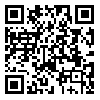Volume 15, Issue 1 (Apr & May 2021)
payavard 2021, 15(1): 1-13 |
Back to browse issues page
Download citation:
BibTeX | RIS | EndNote | Medlars | ProCite | Reference Manager | RefWorks
Send citation to:



BibTeX | RIS | EndNote | Medlars | ProCite | Reference Manager | RefWorks
Send citation to:
Soheili F, Jasri S, Khaseh A A, Danesh F. Usability of Mobile Website of the Libraries of Top Medical Sciences Universities in Iran. payavard 2021; 15 (1) :1-13
URL: http://payavard.tums.ac.ir/article-1-6971-en.html
URL: http://payavard.tums.ac.ir/article-1-6971-en.html
1- Associate Professor, Department of Knowledge and Information Science, Payam-e-Noor University, Tehran, Iran
2- Master of Science in Knowledge and Information Science, Payam-e-Noor University, Tehran, Iran
3- Assistant Professor, Department of Information Management, Regional Information Center for Science and Technology (RICeST), Shiraz, Iran ,farshiddanesh@ricest.ac.ir
2- Master of Science in Knowledge and Information Science, Payam-e-Noor University, Tehran, Iran
3- Assistant Professor, Department of Information Management, Regional Information Center for Science and Technology (RICeST), Shiraz, Iran ,
Abstract: (2704 Views)
Background and Aim: One of the essential methods of evaluating academic libraries’ mobile websites is the usability analysis method; websites’ usability means their ease and simplicity of use. This study aims to evaluate the usability of the mobile website of the libraries of top medical universities in Iran. This study aims to evaluate the usability of mobile websites of the libraries of top Iranian universities of medical sciences.
Materials and Methods: This study was done by the descriptive-survey method. The study’s statistical population includes mobile websites of the libraries of the top 50 universities of medical sciences in Iran, which have gained the highest rank in universities’ webometrics ranking in January 2019. The tool used in this study was a checklist. Data analysis was performed by descriptive and analytical statistical methods and SPSS software.
Results: The data analysis showed that in terms of usability of the mobile websites of university libraries, Kerman, Birjand, and Tehran universities of medical sciences were in the first to third ranks with 89.23%, 84.62%, and 81.54%, respectively. Neishabour, Gonabad, and Semnan universities of medical sciences were the last ranks with 40%, 43.08%, and 44.62%., respectively. The evaluation of the research components showed that “system visibility status,” “assisting the user in identifying, detecting and compensating for errors,” and “guidance and documentation” were in the best situation, and components of “error prevention,” “flexibility and system efficiency,” and “User control and freedom” were in their worst condition.
Conclusion: Given the increasing influence and popularity of smart cell phones in the professional life of academics, it is necessary for administrators and designers of mobile websites of academic libraries to consider the applicability and effectiveness of mobile websites of the research community, taking into account the practical findings of the present study.
Materials and Methods: This study was done by the descriptive-survey method. The study’s statistical population includes mobile websites of the libraries of the top 50 universities of medical sciences in Iran, which have gained the highest rank in universities’ webometrics ranking in January 2019. The tool used in this study was a checklist. Data analysis was performed by descriptive and analytical statistical methods and SPSS software.
Results: The data analysis showed that in terms of usability of the mobile websites of university libraries, Kerman, Birjand, and Tehran universities of medical sciences were in the first to third ranks with 89.23%, 84.62%, and 81.54%, respectively. Neishabour, Gonabad, and Semnan universities of medical sciences were the last ranks with 40%, 43.08%, and 44.62%., respectively. The evaluation of the research components showed that “system visibility status,” “assisting the user in identifying, detecting and compensating for errors,” and “guidance and documentation” were in the best situation, and components of “error prevention,” “flexibility and system efficiency,” and “User control and freedom” were in their worst condition.
Conclusion: Given the increasing influence and popularity of smart cell phones in the professional life of academics, it is necessary for administrators and designers of mobile websites of academic libraries to consider the applicability and effectiveness of mobile websites of the research community, taking into account the practical findings of the present study.
Type of Study: Original Research |
Subject:
Medical Library & Information Sciences
ePublished: 1399/07/23
ePublished: 1399/07/23
Send email to the article author
| Rights and permissions | |
 |
This work is licensed under a Creative Commons Attribution-NonCommercial 4.0 International License. |






